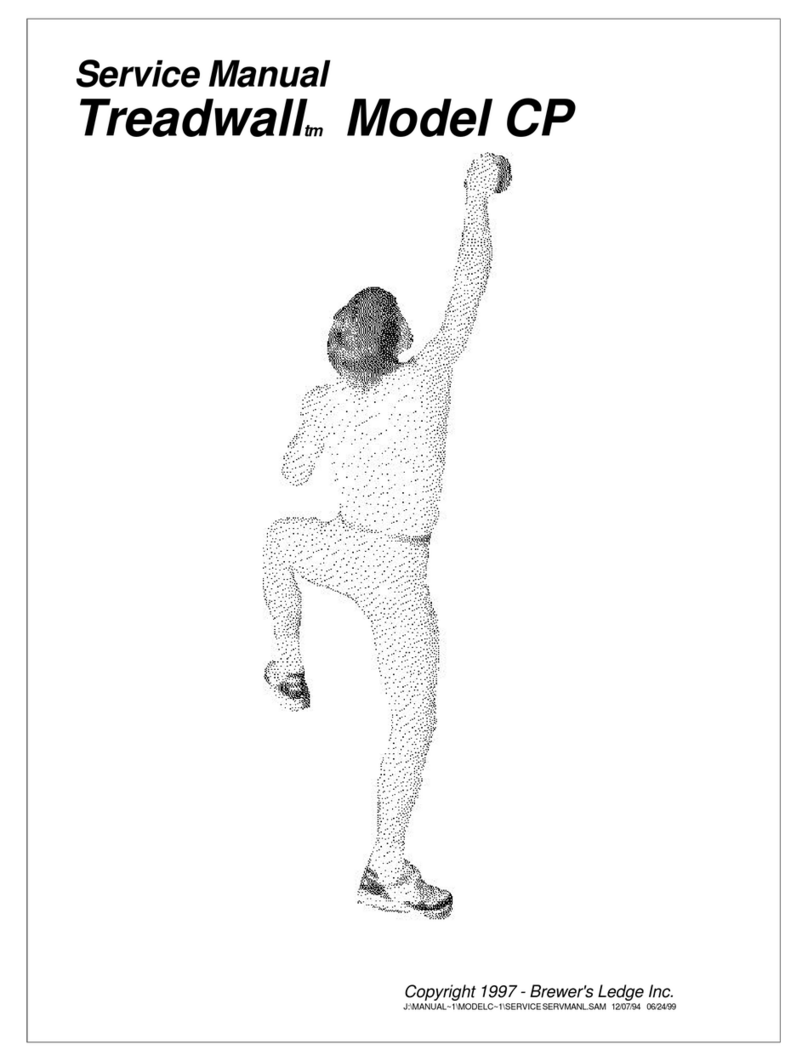
Page 1
Brewer’s Ledge Inc. ? 34 Brookley Road ? Boston MA 02130
800-707-9616 ? www.treadwall.com
SERVICE MANUAL body 11-15-07.doc
TREADWALL MAINTENANCE
Treadwall® maintenance is easy and requires only
lubrication and attention to a number of adjustments
relating to the alignment of the wall.
The most important maintenance of the Treadwall occurs
during the first month of operation when the chains and
cables are stretching to their final length. It is very
important to keep the angle-adjuster cables tight during
this break-in period so that the winds remain even and do
not overlap. Also the drive chain and panel chains must
be tightened after 2-3 weeks of use. Instructions for
these adjustments are found inside of the control panel
cover. This card is re-printed below:
THE CRUCIAL FIRST MONTH:
Following these instructions for adjustment
during the break-in period is very important to
the health of your Treadwall. These simple
adjustments assure that stretching chains and
cables will not result in damage to the
machine. After the first month, maintenance
requirements are very low.
After the initial break-in period, follow the
schedule below.
SERVICE INTERVAL
(MONTHS)
MAINTENANCE
ITEM
2 6 12
Cable tension X
Drive chain tension X
Main chain tension X
Lube channels X
Clean holds X
Drive Chain Adjustment:
The drive chain connects the pump in this panel to the top shaft. Over time, the
chain will stretch and need adjustment.
•Use the long push-down bolt (A) to push down the pump and panel. This
will tighten the chain. As you adjust the chain you can feel the amount of
slack through the round access hole (B). Adjust slowly and just take out the
excess slack. Do not over-tighten or the Treadwall will operate sluggishly.
•If you over-tighten the chain by mistake, loosen the push-down bolt (A) and
pry the chain through the access hole (B) with a large screwdriver or wrench
to loosen it up.
Cable Turnbuckles:
The cables that adjust the angle of the wall must be kept tight. If they become
loose, fraying and breakage will result.
•Check and tighten the turnbuckles (C) often during the first two weeks of
operation as the cables stretch to their final length. Make the turnbuckles as
tight as you can by hand. Do not over-tighten with a tool. Check monthly and
tighten as necessary.
Interior Turnbuckles:
The turnbuckles inside the wall (D) keep it from swaying from side to side. They
should be wired closed and should not loosen up in normal use.
•If they become loose, make them finger tight (no more) and wire them
closed.
Main Chains:
•The wall panels hang from heavy-duty chains inside of the wall.
•These chains should be sprayed with chain lube every six months. Spray
through the access holes as an assistant moves the wall around.
•The main chains occasionally need
re-adjusting as they stretch. If the
wall hangs up, check at "point x". If
the main chains are loose, the
panels will jam trying to enter the
channel at this point.
•To tighten the chains, loosen the
bearing mounting bolts slightly and
use the chain tension adjusters (E)
to push down the adjustable
bearings at the bottom of the
channels. Just a turn or two should
be enough to take out the slack. If
you tighten them too much, the wall
will operate sluggishly. When the
chains are adjusted properly, the
panels should clear the flange at
'point x' with about 1/2" of
clearance.
CLEANING HOLDS.
Clean holds make a big difference in the
climbing experience. As the Treadwall is
used, the climbing holds get contaminated
with dirt and grime and eventually become
slick and greasy to the touch and unpleasant
to climb on.
When you look at dirty holds, you may think
that they need replacing, but really all they
need is a good cleaning. If you take them off
and run them through a dishwasher for a
couple of cycles or just scrub them off in a
sink with a brush and soap, you will be
amazed at how much better they look and
feel.
You don’t need to clean them all at once. If
you just take off the 10 dirtiest holds every
month or so and give them a good washing,
you can rotate them around and keep them in
good shape.
TOUCH-UP PAINT:
Treadwall panels are painted with a high-
quality enamel paint that is very dark gray. A
mixture of 50% battleship gray and 50% black
will give a good match for touch-up purposes.
The white frame color can be matched with
automotive touch up paint: Toyota #3226.
Point x





































